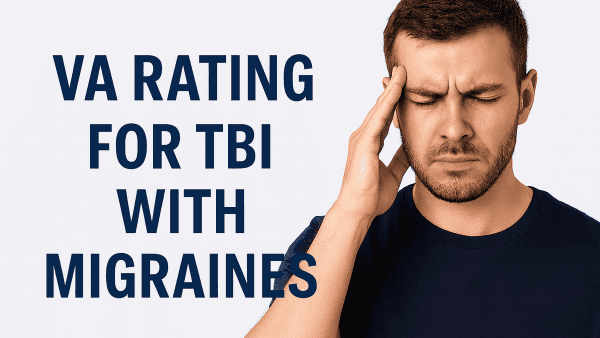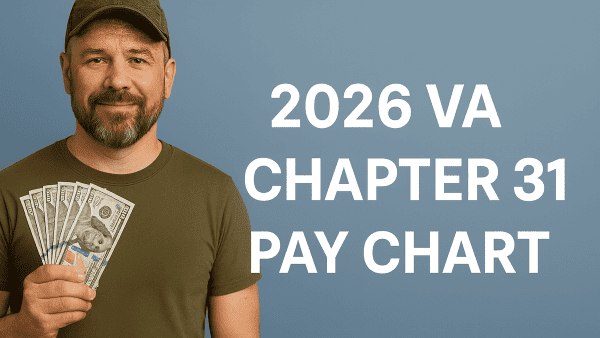Looking for Expert-Level VA Claim Answers?📱Call Us Now! 737-295-2226
If you’re pursuing VA disability benefits, then you may have heard of VA pyramiding.
This post explains the federal law against VA disability pyramiding and how it can affect your VA claims, VA rating, and VA disability benefits.
Let’s get into it!

What is the VA Pyramiding Rule?
The VA pyramiding rule says that only one disability rating can be awarded for each symptom produced by a service-connected disability.
It comes from 38 CFR 4.14-1 “Avoidance of pyramiding.”
Put another way, if separate disabilities cause identical symptoms, you cannot receive separate disability ratings. The ‘legalese’ used in CFR 38 4.14 states that, “the evaluation of the same disability under various diagnoses is to be avoided.”
There is a subtle nuance here that you need to pick up on in order to understand this rule:
Notice that we say, “one disability rating can be awarded for each symptom“, not “each disability.”
But doesn’t the VA award ratings for service-connected disabilities?
Not exactly…
How the VA Rates Disabilities
Technically, the VA rates symptoms that are produced by service-connected disabilities.
Once the VA decides that your disability was caused or aggravated by your military service, they review documents such as your medical records, lay statements, Independentmedical opinions (IMOs), disability benefits questionnaires (DBQs), and others, in order to determine how negatively your symptoms affect your life.
Based on their review, they then use the Veterans Affairs Schedule for Rating Disabilities (VASRD) to determine your disability percentage. This schedule lays out specific instructions for what disability percentage to assign to a disability based on the symptom(s) it produces.
Generally speaking, the more your symptoms negatively affect your life, the higher your rating, and vice versa.
This is why it’s possible to have a non-compensable 0% VA rating (this is when you have a rating but don’t get monthly compensation).
In these cases, the VA recognizes that your disability is service-connected, but your symptoms don’t negatively affect your life enough to warrant compensation.
While you won’t get monthly disability compensation with a 0% rating, you’re still eligible for other benefits.

Deserve a Higher VA Rating?
Book a no-obligation VA Claim Discovery Call with an experienced team member. We’ll review your situation, spot what the VA may have missed, and help you map out a strategy to unlock the VA disability rating and tax-free compensation you’ve earned for your service. Click the red button below to book your call.
How VA Pyramiding Can Affect Your VA Disability Rating
Because of the VA pyramiding rule outlined in CFR 38 4.14, if you have more than one disability and they produce similar symptoms or overlapping symptoms, your disability compensation is likely going to be lower than you’d like.
PRO TIP: See our blog VA Math – What is it? to learn more about how the VA calculates combined ratings.
Even if you have 3 service-connected disabilities, if they all produce the same symptom of knee pain, you’re going to receive one rating for knee pain, not 3 separate ratings.
Below are a two examples of common ratable conditions with overlapping symptoms:
VA Disability Pyramiding Example: PTSD and Depression
The VA pyramiding rule comes into effect for most mental health conditions.
This is because the VA uses the same rating criteria for almost all mental health disorders, PTSD (DC 9411) and Major Depressive Disorder (DC 9434) being just two of them.
Example: Rating criteria for PTSD and Depression:
| General Rating Formula for Mental Disorders | Rating |
| Total occupational and social impairment, due to such symptoms as: gross impairment in thought processes or communication; persistent delusions or hallucinations; grossly inappropriate behavior; persistent danger of hurting self or others; intermittent inability to perform activities of daily living (including maintenance of minimal personal hygiene); disorientation to time or place; memory loss for names of close relatives, own occupation, or own name. | 100 |
| Occupational and social impairment, with deficiencies in most areas, such as work, school, family relations, judgment, thinking, or mood, due to such symptoms as: suicidal ideation; obsessional rituals which interfere with routine activities; speech intermittently illogical, obscure, or irrelevant; near-continuous panic or depression affecting the ability to function independently, appropriately and effectively; impaired impulse control (such as unprovoked irritability with periods of violence); spatial disorientation; neglect of personal appearance and hygiene; difficulty in adapting to stressful circumstances (including work or a worklike setting); inability to establish and maintain effective relationships. | 70 |
| Occupational and social impairment with reduced reliability and productivity due to such symptoms as: flattened affect; circumstantial, circumlocutory, or stereotyped speech; panic attacks more than once a week; difficulty in understanding complex commands; impairment of short- and long-term memory (e.g., retention of only highly learned material, forgetting to complete tasks); impaired judgment; impaired abstract thinking; disturbances of motivation and mood; difficulty in establishing and maintaining effective work and social relationships. | 50 |
| Occupational and social impairment with occasional decrease in work efficiency and intermittent periods of inability to perform occupational tasks (although generally functioning satisfactorily, with routine behavior, self-care, and conversation normal), due to such symptoms as: depressed mood, anxiety, suspiciousness, panic attacks (weekly or less often), chronic sleep impairment, mild memory loss (such as forgetting names, directions, recent events). | 30 |
| Occupational and social impairment due to mild or transient symptoms which decrease work efficiency and ability to perform occupational tasks only during periods of significant stress, or symptoms controlled by continuous medication. | 10 |
| A mental condition has been formally diagnosed, but symptoms are not severe enough either to interfere with occupational and social functioning or to require continuous medication. | 0 |
There are 31 mental disorders that are rated according to the above chart. So if you have more than one, it will be very difficult to determine what disability is causing what symptom.
Example: Musculoskeletal System
Several disabilities in the musculoskeletal category also have the same symptoms.
For example, check out the rating criteria for (diagnostic codes) DC 5256 and DC 5260:
| DC 5256 Knee, Ankylosis | Rating |
| Extremely unfavorable, in flexion at an angle of 45° or more | 60 |
| In flexion between 20° and 45° | 50 |
| In flexion between 10° and 20° | 40 |
| Favorable angle in full extension, or in slight flexion between 0° and 10° | 30 |
| DC 5260 Leg, Limitation of Flexion | Rating |
| Flexion limited to 15° | 30 |
| Flexion limited to 30° | 20 |
| Flexion limited to 45° | 10 |
| Flexion limited to 60° | 0 |
Both rating charts deal with limited flexion of the knee. But which chart applies? That’s the tricky thing the VA has to determine.
According to DC 5256, limited flexion of the knee of 45 degrees qualifies you for a 50% rating. But according to DC 5260, limited flexion of 45 degrees only qualifies you for a 10% VA disability rating.
In this case, the single rating the VA would award is the higher rating. But you get the point; There are many conditions with the same manifestation of symptoms.

VA Pyramiding Rule and C&P Exams: How to Avoid Pyramiding VA Disability
Getting your symptoms correctly documented can make all the difference between falling victim to the VA pyramiding rule and getting the rating you deserve.
The VA uses evidence from exams, such as your Compensation and Pension Exam (C&P), to determine what symptoms are caused by what disability and what rating to assign to the symptoms.
Your C&P Exam can make or break your claim in more ways than this one. They’re important for documenting symptoms as well as establishing service connection.
Acing your C&P Exam
The details really matter during your C&P Exam.
Attributing symptoms to specific disabilities can be tricky, especially for mental health conditions as we’ve already noted. The more specific you can be, the better. Vulnerable details can really help the doctor decide what disability is causing your symptoms.
This means you should show up to your C&P Exam prepared to talk in detail about what symptoms you experience, how severe they are, how frequently you experience them, how long you’ve had them, and how long they last.
Even if you think you’ll sound like a wimp, or a complainer, or whatever other stigma you’ve heard, ignore all that!
Tell the doctor the details—even the embarrassing ones. This could really help your claim.
One pro tip is to keep a symptom log. Whenever you have a symptom, describe what it is, how much it hurts, how long it lasts, and how it affected your life (e.g. did it cause you to have to stop working?).
Again, the more detail the better.
Read our blog 10 EXPERT Tips to DOMINATE Your C&P Exam for more on acing your C&P Exam.
NOTE: It’s critical that you’re honest during all medical exams throughout your claims process. You don’t want to wake up one day to a letter or email from the VA accusing you of fraud.
Do not lie during your C&P Exam, on a DBQ, or any other VA form.

VA Pyramiding and IMOs
Another way to get your symptoms thoroughly documented so you don’t fall victim to the pyramiding rule is with an Independent Medical Opinion (IMO).
IMOs are conducted by providers who aren’t employed by Veterans Affairs. This helps keep them unbiased. They’re also usually specialists in the conditions that you want to claim for VA disability, which means their opinion carries a lot of weight.
The VA has to consider IMOs when they’re submitted with your claim. They can also come in handy if you’ve been denied and need to file an appeal.
By joining the VA Claims Insider Elite program, you can get access to our network of preferred independent providers who can write IMOs that improve your claim. You can also get access to discounted Nexus Letters through this network.

NEED MORE ASSISTANCE?
Most veterans are underrated for their disabilities and, therefore, not getting their due compensation.
At VA Claims Insider, we guide you and take control of the claims process so you may get the rating and compensation you’re owed by law. If you’ve filed your VA disability claim and have been denied or have received a low rating—or you’re unsure how to get started—reach out to us!
Our process takes the guesswork out of filing a VA disability claim and supports you in building a fully developed claim (FDC)—so you may increase your rating FAST! Take advantage of a FREE VA Claim Discovery Call. Learn what you’ve been missing—so you can FINALLY get the disability rating and compensation YOU DESERVE!

Clay Huston
Clay Huston is a former U.S. Army Reserves Blackhawk Pilot and officer. Clay enlisted in the Army in 2013 and was commissioned as a 2LT in 2017 after earning a business degree from the University of Illinois Champaign-Urbana.
Since separating from the military, Clay has pursued a career as a writer. He also runs the nonprofit notfatherless.org, which fundraises for Children’s Homes in Mexico.



